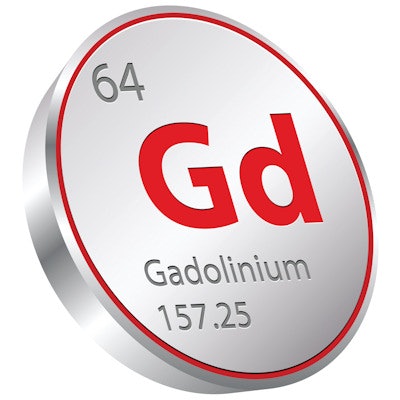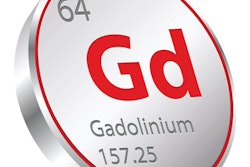
Which factors are most likely to trigger an adverse event from administration of a gadolinium-based contrast agent (GBCA)? The GBCA itself as well as a patient's age, gender, and type of MRI scan could increase chances of an allergic reaction, according to a study published online July 2 in Radiology.
In a review of more than a half-million injections of four GBCA products, researchers found that gadobenate dimeglumine (MultiHance, Bracco Imaging) and gadobutrol (Gadavist, Bayer HealthCare) were associated with higher rates of mild or moderate allergic reactions, compared with two other GBCAs. In addition, a greater risk of a mild or moderate adverse reaction to contrast was found in patients between the ages of 21 and 50 years, those undergoing an outpatient GBCA-enhanced MRI, and women.
"These results demonstrate that the rate of acute GBCA reactions varies between GBCA type and is associated with specific patient demographics," wrote lead author Jennifer McDonald, PhD, and colleagues from the Mayo Clinic in Rochester, MN.
GBCA research
Several studies have been published in recent years that indicate the frequency of adverse allergic events from linear and macrocyclic GBCAs is quite rare. Acute GBCA reactions are considered to be a separate issue from gadolinium deposition, which is typically tracked over a period of months and years rather than immediately after contrast administration.
While the rarity of acute GBCA reactions is good news for patients, it does pose a problem for researchers who prefer much more substantial data from which to draw their conclusions.
"These acute adverse events are uncommon and most frequently occur within one hour of intravenous GBCA administration, with a reported incidence of seven to 240 per 10,000 injections," McDonald and colleagues noted. "This rarity has made it challenging to compare the rate of reactions between GBCAs and to determine what risk factors are associated with acute reactions."
Thus, the researchers set out on this large single-center retrospective study to compare rates of acute allergic and physiologic reactions at their institution. The study included 158,100 patients (median age, 55 years; range, 40-67 years) who received a total of 281,945 GBCA intravenous injections for MRI scans between June 2009 and May 2017. The facility most commonly used the following four GBCAs:
- Gadodiamide (Omniscan, GE Healthcare)
- Gadobutrol (Gadavist, Bayer)
- Gadobenate dimeglumine (MultiHance, Bracco)
- Gadoterate meglumine (Dotarem, Guerbet)
The researchers excluded infrequently used GBCAs, such as gadoxetate disodium (Eovist, Bayer) and gadopentate dimeglumine (Magnevist, Bayer), which accounted for only 1.9% and 0.8% of total administrations during the study period, respectively.
Allergic reactions that were examined included hives, throat symptoms, shortness of breath, edema, nose or eye issues, and anaphylaxis. Among the physiologic reactions were nausea or vomiting, chest tightness or pain, headache, chills, and seizure. The events were classified as mild, moderate, or severe based on American College of Radiology (ACR) criteria.
"At our institution, all patients are monitored during and after GBCA-enhanced MRI examinations (30 to 45 minutes total) to identify and treat GBCA-mediated acute reactions," the authors noted.
Reaction rates
McDonald and colleagues recorded a total of 442 allergic reactions (16 per 10,000 injections) among the four GBCAs and 374 physiologic reactions (13 per 10,000 injections) during the eight-year period. In total, they noted 591 mild events, 219 moderate cases, and six severe reactions. Three severe adverse events were connected to gadobutrol, and three incidents were tied to gadobenate.
"Of note, the severe reactions that occurred following gadobutrol administration were more serious and required longer hospitalizations than did the severe reactions that occurred following gadobenate administration," the authors added. "Two patients who received gadobutrol required subsequent extracorporeal membrane oxygenation support. No deaths related to GBCA administration were noted."
| Patient reactions to GBCA administration | ||||
| Gadodiamide | Gadobutrol | Gadobenate dimeglumine | Gadoterate meglumine | |
| Total administrations | 140,645 | 94,109 | 39,138 | 8,053 |
| Allergic reactions | ||||
| Mild | 76 (5) | 107 (11) | 77 (20) | 4 (5) |
| Moderate | 46 (3) | 75 (8) | 51 (13) | 0 |
| Severe | 0 (0) | 3 (0) | 3 (1) | 0 |
| Physiologic reactions | ||||
| Mild | 120 (9) | 138 (15) | 64 (16) | 5 (6) |
| Moderate | 24 (2) | 17 (2) | 5 (1) | 1 (1) |
| Severe | 0 | 0 | 0 | 0 |
The most common allergic reactions were hives and throat symptoms, such as itchiness, swelling, and difficulty swallowing; the most common physiologic reactions were nausea or vomiting, dizziness, flushing, and chills.
Risk factors
McDonald and colleagues also found other potential risk factors that could trigger an allergic or physiologic reaction. The additional influencers included age, gender, and where the GBCA-enhanced MRI scan was performed.
For example, patients between the ages of 21 and 50 were significantly more likely to have an adverse reaction to a GBCA than patients between 51 and 60 years of age. Women also were significantly more likely to have an adverse reaction, compared with men. Finally, outpatients were almost twice as likely to have an adverse event than inpatients.
| Risk factors for acute reactions to GBCAs | ||
| Odds ratio | p-value* | |
| Outpatient imaging | 1.9 | 0.009 |
| Female gender | 1.7 | < 0.001 |
| Patient age | ||
| 21-30 years | 1.6 | 0.014 |
| 31-40 years | 1.5 | 0.013 |
| 41-50 years | 1.4 | 0.025 |
While similar studies into adverse reactions to GBCAs have been conducted, the Mayo Clinic researchers noted that their study adds to the current wealth of data because it is the "largest single-center study of GBCA acute reactions to date. The single-center nature of our study strengthens data validity as variables such as nursing and MRI technologist protocols for monitoring, as well as identifying, treating, and documenting GBCA reactions, were standardized during our study time frame."


.fFmgij6Hin.png?auto=compress%2Cformat&fit=crop&h=100&q=70&w=100)





.fFmgij6Hin.png?auto=compress%2Cformat&fit=crop&h=167&q=70&w=250)











